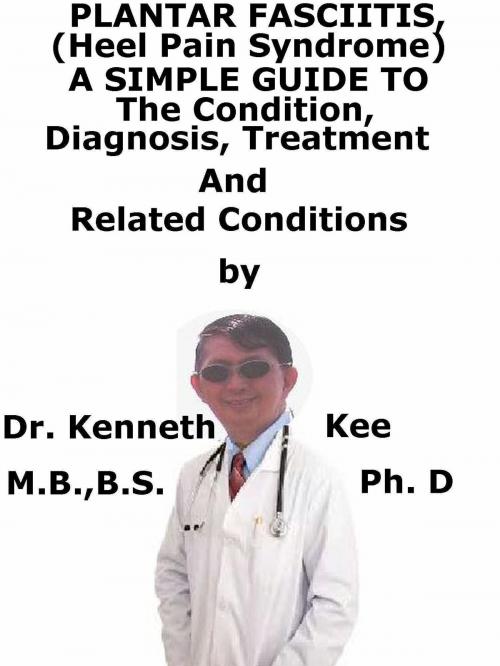Planter Fasciitis, A Simple Guide To The Condition, Diagnosis, Treatment And Related Conditions
Nonfiction, Health & Well Being, Health, Ailments & Diseases, Musculoskeletal, Medical, Specialties, Orthopedics| Author: | Kenneth Kee | ISBN: | 9781370702848 |
| Publisher: | Kenneth Kee | Publication: | November 3, 2016 |
| Imprint: | Smashwords Edition | Language: | English |
| Author: | Kenneth Kee |
| ISBN: | 9781370702848 |
| Publisher: | Kenneth Kee |
| Publication: | November 3, 2016 |
| Imprint: | Smashwords Edition |
| Language: | English |
Plantar Fasciitis (Painful Heel Syndrome) is a medical disorder with inflammation of the plantar fascia (which stretches from the calcaneum to the toes) typically featured by the pain in the heel especially in the morning and weight bearing exercises.
The plantar fascia is a thick connective tissue on the bottom of the foot.
It strengthens the arch of the foot and also works as a shock-absorber in the foot.
It joins the heel bone to the toes and produces the arch of the foot.
When this tissue becomes swollen or inflamed, it is called plantar fasciitis.
Plantar fasciitis happens when the thick band of tissue on the bottom of the foot is over-stretched or over-used.
This can cause pain and make walking more difficult.
The damage is normally near to where the plantar fascia joins to the heel bone.
Plantar fasciitis may be thought to be 'Policeman's heel' but they are different.
Policeman's heel is plantar calcaneal bursitis - inflammation of the bursa (sack of fluid) under the heel bone.
The most frequent symptom is pain and stiffness in the bottom of the heel.
The pain is frequently worsened:
1. In the morning when the patient take the first steps
2. After standing or sitting for awhile
3. When climbing stairs
4. After intense activity
The patient may limp because of the painful heel.
The physical examination may show:
1. Tenderness on the bottom of the foot
2. Flat feet or high arches
3. Mild foot swelling or redness
4. Stiffness or tightness of the arch in the bottom of the foot.
An ultrasound scan normally shows thickening and swelling of the fascia in plantar fasciitis.
Conservative treatments for plantar fasciitis are:
1. Rest the foot
The excess walking, running, or standing and undue stretching of the sole should be avoided.
Gentle walking and exercises below are fine.
2. Footwear
The shoes are chosen with cushioned heels and a good arch support.
A sports shoe rather than an open sandal is the best footwear.
3. Heel pads and arch supports
The patient can purchase various pads and shoe inserts to strengthen the heel and support the arch of the foot.
If the heel is painful, a small hole is cut in the heel pad at the location of the tender spot.
This indicates that the tender part of the heel will not come in contact with anything inside the shoe.
The inserts or pads are placed in both shoes, even if the patient only has pain in one foot.
4. Relief of pain
Painkillers such as paracetamol will frequently relieve the pain.
An ice pack (such as a bag of frozen peas wrapped in a tea towel) placed on the foot for 15-20 minutes may also assist to relieve pain.
5. Exercises
Regular, gentle stretching of the Achilles tendon and plantar fascia may assist to relieve the symptoms.
This is because most people with plantar fasciitis have some tightness of their Achilles tendon.
A steroid (cortisone) injection is sometimes tried if the pain remains bad.
In extracorporeal shock-wave treatment, a machine is used to provide high-energy sound waves through the skin to the painful area on the foot.
New treatments are injection with botulinum toxin and treatment of the plantar fascia with radiotherapy.
Surgery is normally only advised if the pain has not relieved after 12 months and requires separating the plantar fascia from where it joins to the bone.
TABLE OF CONTENT
Introduction
Chapter 1 Plantar Fasciitis
Chapter 2 Causes
Chapter 3 Symptoms
Chapter 4 Diagnosis
Chapter 5 Treatment
Chapter 6 Prognosis
Chapter 7 Flat Foot
Chapter 8 Ankle Sprain
Epilogue
Plantar Fasciitis (Painful Heel Syndrome) is a medical disorder with inflammation of the plantar fascia (which stretches from the calcaneum to the toes) typically featured by the pain in the heel especially in the morning and weight bearing exercises.
The plantar fascia is a thick connective tissue on the bottom of the foot.
It strengthens the arch of the foot and also works as a shock-absorber in the foot.
It joins the heel bone to the toes and produces the arch of the foot.
When this tissue becomes swollen or inflamed, it is called plantar fasciitis.
Plantar fasciitis happens when the thick band of tissue on the bottom of the foot is over-stretched or over-used.
This can cause pain and make walking more difficult.
The damage is normally near to where the plantar fascia joins to the heel bone.
Plantar fasciitis may be thought to be 'Policeman's heel' but they are different.
Policeman's heel is plantar calcaneal bursitis - inflammation of the bursa (sack of fluid) under the heel bone.
The most frequent symptom is pain and stiffness in the bottom of the heel.
The pain is frequently worsened:
1. In the morning when the patient take the first steps
2. After standing or sitting for awhile
3. When climbing stairs
4. After intense activity
The patient may limp because of the painful heel.
The physical examination may show:
1. Tenderness on the bottom of the foot
2. Flat feet or high arches
3. Mild foot swelling or redness
4. Stiffness or tightness of the arch in the bottom of the foot.
An ultrasound scan normally shows thickening and swelling of the fascia in plantar fasciitis.
Conservative treatments for plantar fasciitis are:
1. Rest the foot
The excess walking, running, or standing and undue stretching of the sole should be avoided.
Gentle walking and exercises below are fine.
2. Footwear
The shoes are chosen with cushioned heels and a good arch support.
A sports shoe rather than an open sandal is the best footwear.
3. Heel pads and arch supports
The patient can purchase various pads and shoe inserts to strengthen the heel and support the arch of the foot.
If the heel is painful, a small hole is cut in the heel pad at the location of the tender spot.
This indicates that the tender part of the heel will not come in contact with anything inside the shoe.
The inserts or pads are placed in both shoes, even if the patient only has pain in one foot.
4. Relief of pain
Painkillers such as paracetamol will frequently relieve the pain.
An ice pack (such as a bag of frozen peas wrapped in a tea towel) placed on the foot for 15-20 minutes may also assist to relieve pain.
5. Exercises
Regular, gentle stretching of the Achilles tendon and plantar fascia may assist to relieve the symptoms.
This is because most people with plantar fasciitis have some tightness of their Achilles tendon.
A steroid (cortisone) injection is sometimes tried if the pain remains bad.
In extracorporeal shock-wave treatment, a machine is used to provide high-energy sound waves through the skin to the painful area on the foot.
New treatments are injection with botulinum toxin and treatment of the plantar fascia with radiotherapy.
Surgery is normally only advised if the pain has not relieved after 12 months and requires separating the plantar fascia from where it joins to the bone.
TABLE OF CONTENT
Introduction
Chapter 1 Plantar Fasciitis
Chapter 2 Causes
Chapter 3 Symptoms
Chapter 4 Diagnosis
Chapter 5 Treatment
Chapter 6 Prognosis
Chapter 7 Flat Foot
Chapter 8 Ankle Sprain
Epilogue















